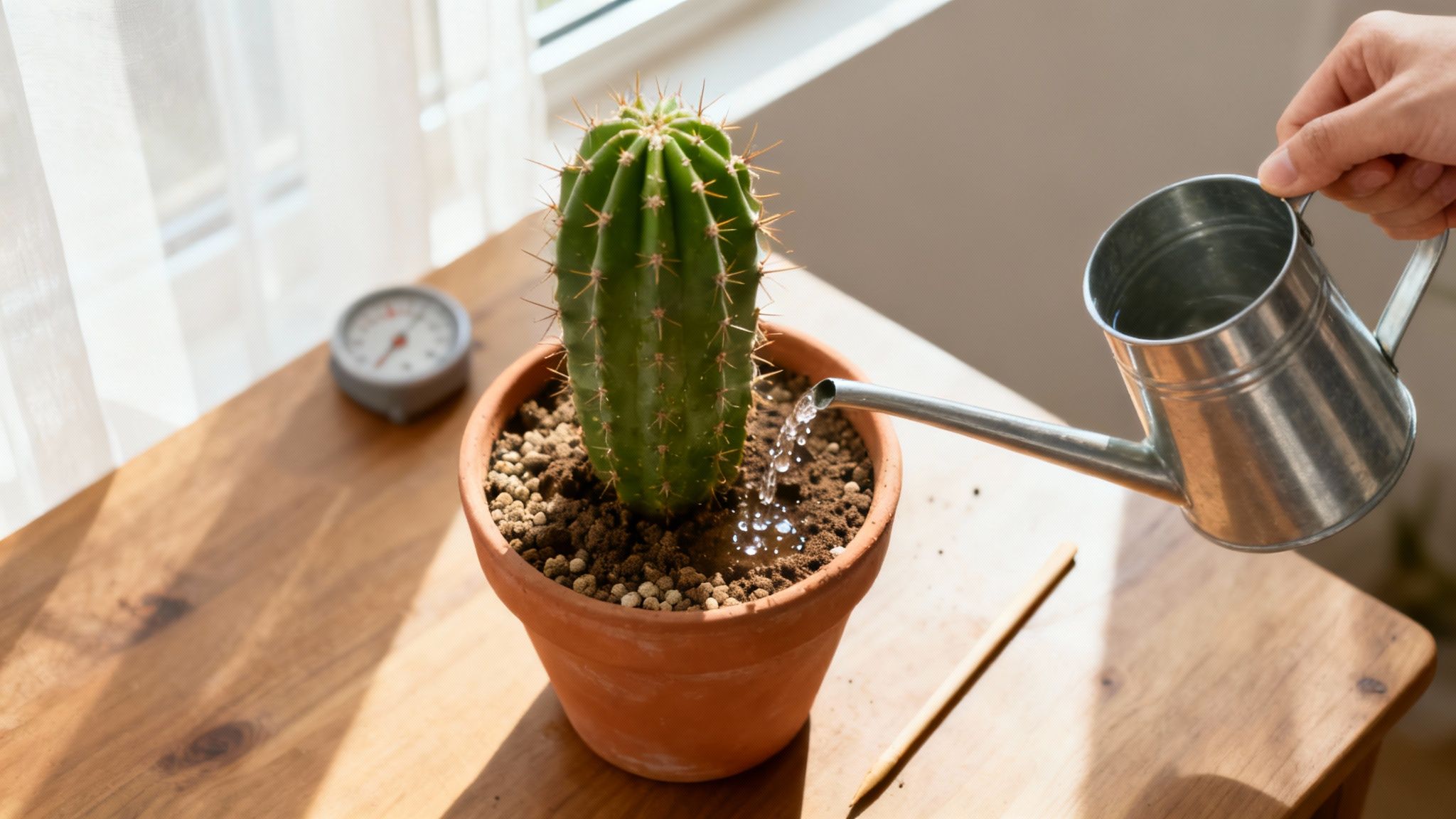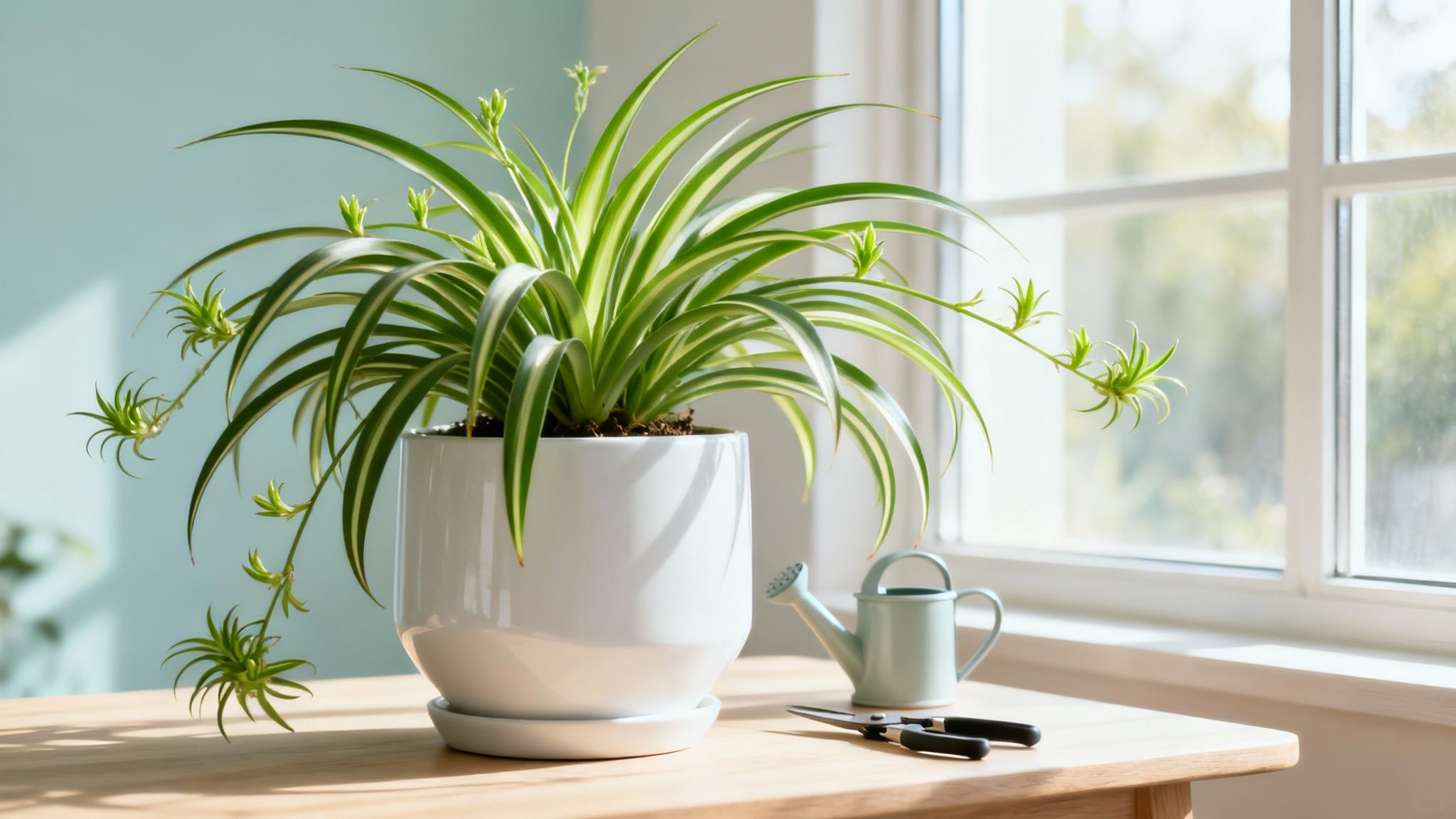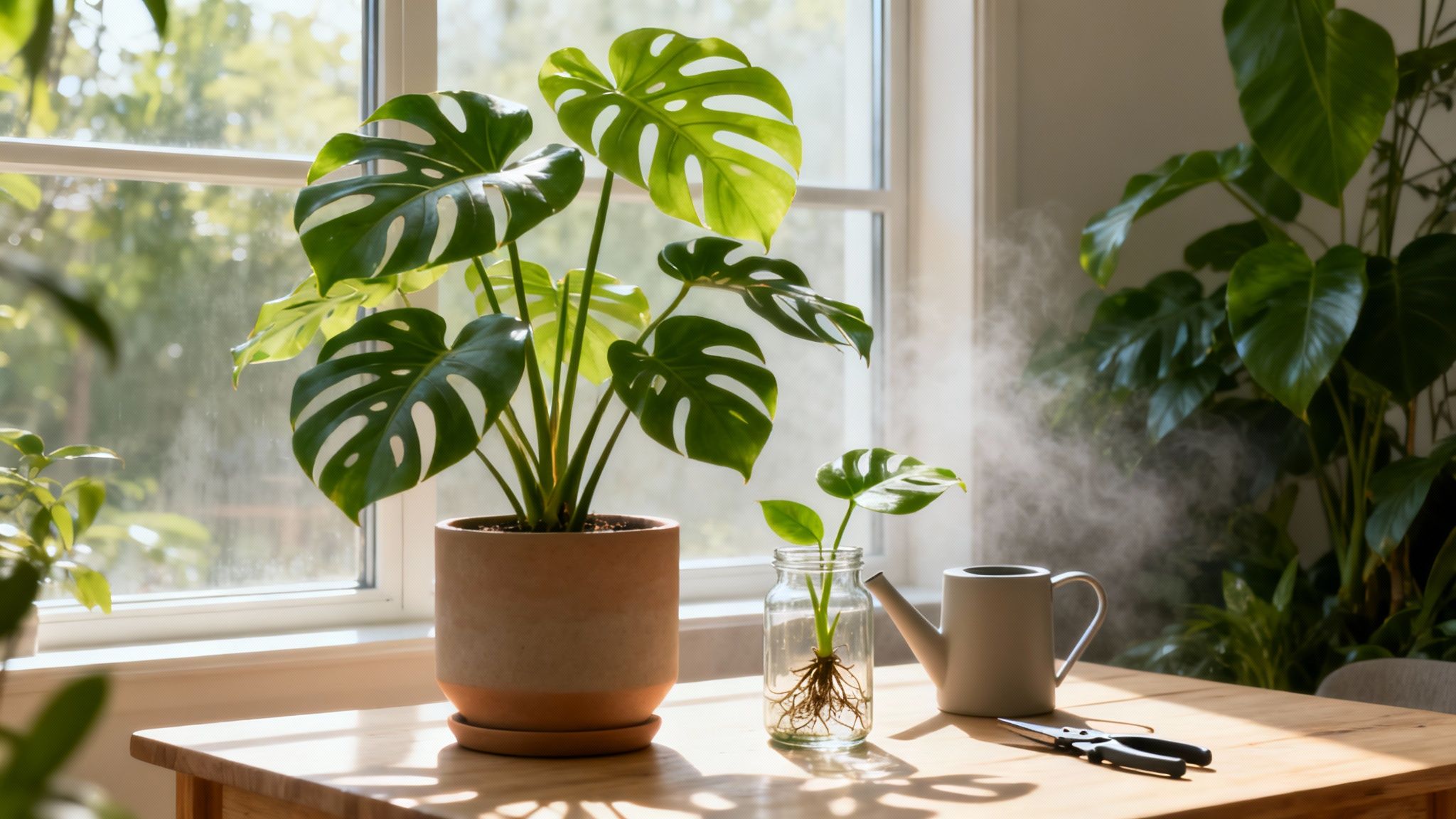We’ve all been there. You bring home a gorgeous new cactus, full of good intentions, only to find it looking sad and mushy a few weeks later. If this sounds familiar, you’re not alone. The single most common hurdle in cactus care is figuring out the right watering routine. Forget rigid schedules; the key is to embrace the ‘soak and dry’ method, an approach that perfectly mimics the rare but heavy downpours these resilient plants evolved to expect in their native desert habitats. This guide will teach you how to read your plant’s signals and provide the perfect amount of water, every time.
The Most Common Cactus Care Mistake
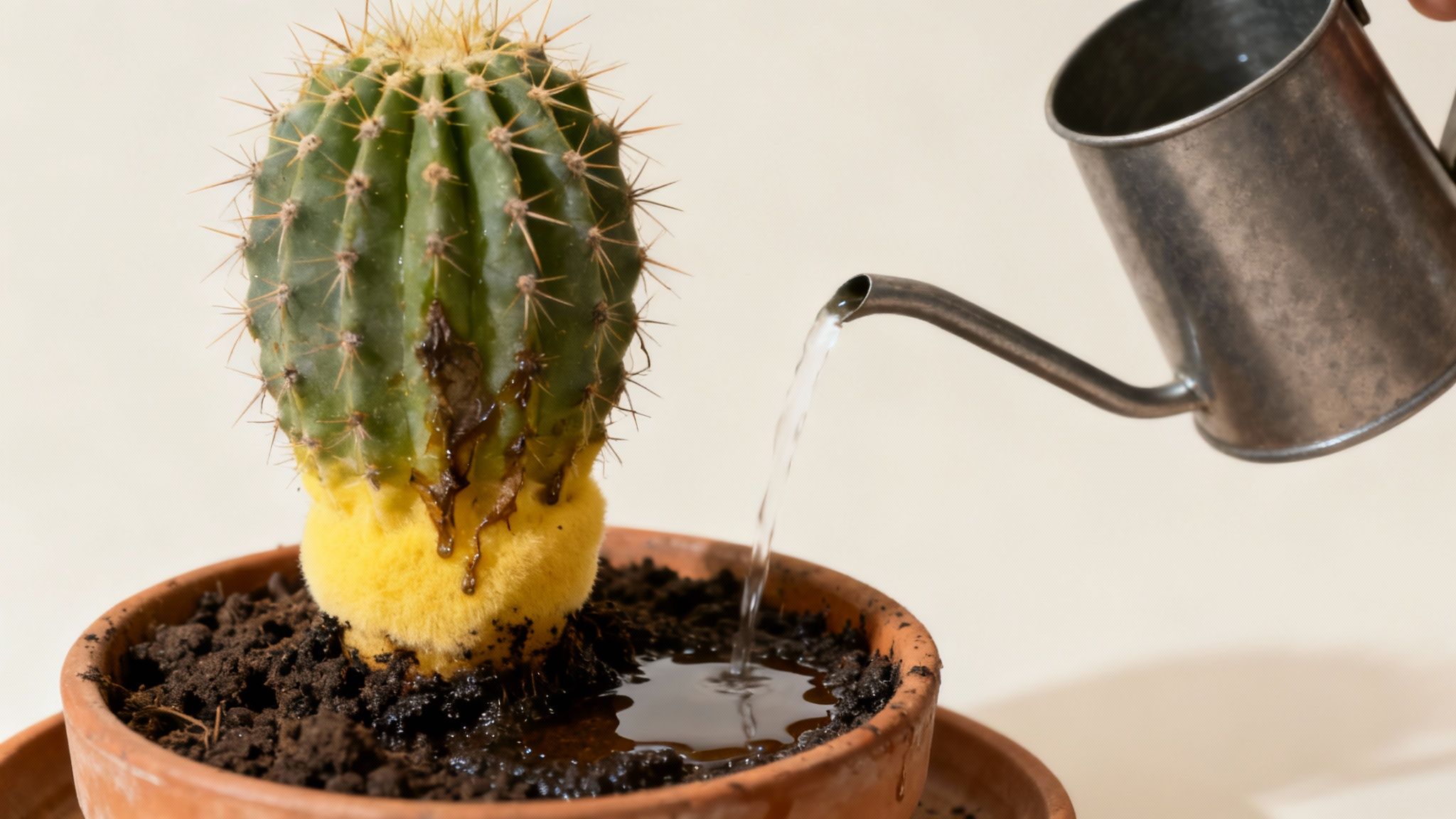
Don't feel bad—overwatering is, by far, the number one killer of cacti. These incredibly resilient plants have adapted to survive long stretches of drought, followed by a thorough drenching. When you water too often, their roots, which are designed to absorb moisture rapidly, simply can't cope. They get suffocated by the constant moisture and inevitably begin to rot.
This isn't just anecdotal. A recent survey found that about 42% of indoor cactus plants don't make it past their first year because of improper watering. Of those, a staggering 78% were due to overwatering. You can dig deeper into these horticultural stats over at Grand View Research.
Understanding Your Cactus's Needs
To sidestep this common pitfall, you have to shift your mindset. Stop thinking about a calendar and start paying attention to your plant's actual thirst signals. The goal is simple: let the soil become bone dry all the way through before you even think about watering again. This one change prevents root rot and encourages your cactus to develop a strong, healthy root system.
So, how do you know when it's time? Look for these tell-tale signs:
The soil is visibly pulling away from the sides of the pot.
The pot feels surprisingly light when you pick it up.
You can stick a wooden skewer or chopstick deep into the soil, and it comes out completely clean and dry.
A Smarter Way to Water
All this guesswork can be stressful, especially for beginners. This is where a little modern tech can help build your confidence. Using an app like Tendra for smart care reminders can track when you last watered and give you a gentle nudge when it might be time to check the soil again—not just water on autopilot. These tools help you build good habits based on observation, not assumption.
The real trick is learning to spot your cactus’s genuine signs of thirst instead of watering out of habit. When you align with its natural rhythm, you're setting it up for a long, happy life. In this guide, we'll walk you through exactly how to master the soak and dry method so you can water your cactus correctly, every single time.
How Seasonal Changes Affect Your Cactus Watering Schedule
It's a common mistake to think all cacti are the same. In reality, treating them identically is like assuming everyone has the same appetite—it just doesn't work. The real secret to happy cacti is tuning into their natural rhythms, which are all about the changing seasons and their specific species. A cactus isn't just a static decoration; it's a living thing with clear cycles of growth and rest.
When spring and summer roll around, your cactus is in its active growing season. It's busy pushing out new pads, spines, and maybe even some stunning flowers. This is when it's thirstiest and will get the most out of a consistent watering a cactus plant routine using the soak-and-dry method.
But as the days get shorter and the weather cools in fall and winter, most cacti hit the brakes and go dormant. Their metabolism slows to a crawl, and they stop growing altogether. Watering too often during this rest period is one of the fastest ways to invite root rot, which is often a death sentence.
Different Species, Different Needs
On top of the seasonal cycle, the specific type of cactus you have is a huge factor. Desert cacti and tropical cacti, for instance, have completely different ideas about what "enough" water means. You can't treat them the same and expect good results.
Desert Cacti: Think of icons like the Golden Barrel Cactus (Echinocactus grusonii) or the classic Prickly Pear (Opuntia ficus-indica). These are true survivors of arid climates. They absolutely need a distinct, dry winter dormancy to thrive and are incredibly sensitive to overwatering when it's cold.
Tropical Cacti: Then you have epiphytic species from rainforests, like the Christmas Cactus (Schlumbergera buckleyi) or Orchid Cactus (Epiphyllum spp.). These plants don't require a bone-dry rest. They actually appreciate a bit more moisture and humidity year-round, though you'll still want to cut back on watering in the fall to encourage them to set buds for their famous holiday blooms.
A Seasonal Watering Guide
Understanding these differences is the key to success. More than anything, it's about observation. No matter what the calendar says, always, always check the soil before you even think about grabbing the watering can.
The best cactus growers I know think less about a rigid schedule and more about what the plant is actively doing. The science backs this up, too. Less frequent, deep watering builds much stronger plants. One study found that cacti watered monthly grew 23% taller and developed 31% more robust root systems than those watered weekly. You can learn more about these findings on cactus water research.
As you head into the cooler months, it isn't just about watering less—it's about getting your entire garden ready for the shift. For a deeper look at that, check out our complete guide to a garden in fall.
To make things a bit simpler, here’s a quick reference table I put together for some of the most common cacti people grow at home.
Seasonal Watering Frequency for Common Cactus Types
This table is a great starting point for adjusting your watering schedule. Use it as a guide, but remember to let your plant's soil be the final judge.
| Cactus Type (Scientific Name) | Spring/Summer (Growing Season) | Fall/Winter (Dormant Season) |
|---|---|---|
| Golden Barrel (Echinocactus grusonii) | Water every 2-4 weeks, once soil is completely dry. | Water very rarely, maybe once every 6-8 weeks, or not at all. |
| Christmas Cactus (Schlumbergera buckleyi) | Water when the top inch (2.5 cm) of soil is dry. | Reduce watering after blooming to encourage rest, then resume in spring. |
| Prickly Pear (Opuntia ficus-indica) | Water every 2-3 weeks, allowing soil to dry out fully. | Water sparingly, only if pads look significantly shriveled. |
| Saguaro Cactus (Carnegiea gigantea) | For potted specimens, water every 3-4 weeks. | Withhold water almost entirely unless severe shriveling occurs. |
This should cover some of the most popular varieties, but it's by no means an exhaustive list.
If you're ever scratching your head about what kind of cactus you actually have, Tendra’s AI plant identification can give you an accurate ID in seconds. That unlocks a tailored care guide, taking all the guesswork out of its seasonal needs.
Mastering the Soak and Dry Watering Method
If you take away just one thing about watering a cactus, let it be this: the soak and dry method is your key to success. It’s a simple, powerful technique that directly mimics the infrequent but heavy downpours these plants get in their native desert homes.
By copying this natural cycle, you’re encouraging your cactus to grow a deep, robust, and resilient root system. Forget about splashing a little water on the soil every few days—that’s a recipe for disaster. This is all about giving your plant a thorough drenching, then letting it dry out completely.
How the Method Works
First things first, you need to be sure the soil is bone-dry. A simple wooden skewer or chopstick is your best tool for this job. Push it all the way to the bottom of the pot. If it comes out with any damp soil clinging to it, hold off on watering for a few more days.
Once you’ve confirmed it’s time, give the soil a good, even soak. Keep watering until you see a generous amount flowing freely from the pot's drainage holes. This is how you know the entire root ball has been saturated.
After the big drink, let the pot drain completely. Whatever you do, never let your cactus sit in a saucer full of water. That’s a fast track to the root rot we’re trying so hard to avoid. Now for the most crucial part: you wait. Don't even think about watering again until that soil has dried out completely.
Fine-Tuning Your Technique
A couple of small adjustments can make your soak and dry method even more effective. Try to water your cactus in the morning if you can. This gives the plant the entire day to absorb moisture while any excess on the surface evaporates, cutting down the risk of fungal problems.
Pro Tip: If possible, use rainwater or distilled water. Tap water often contains minerals that can build up in the soil over time, which can eventually interfere with your plant's ability to absorb nutrients.
Learning to Spot the Signs of Watering Stress
Your cactus is always talking to you; you just need to learn its language. Picking up on the early signs of watering stress is probably the single most important skill you can develop. Catching problems early lets you fix them long before any real damage is done.
A happy, well-watered cactus is firm to the touch. Its color is vibrant, and its pads or stem look plump and full. When that balance gets thrown off, your plant will start showing you physical signs. The trick is learning to tell the difference between "too much" and "not enough."
The Telltale Signs of Overwatering
Overwatering is, without a doubt, the number one killer of cacti. It's far more dangerous than underwatering because it leads straight to root rot—a condition that's often a death sentence if not caught immediately. The signs can be sneaky at first but will get serious fast.
Keep an eye out for these red flags:
A Soft or Mushy Base: The part of the cactus right at the soil line feels soft, squishy, or unstable. This is the classic sign that the roots and the base of the plant are starting to rot away.
Yellowing or Browning: The plant’s color starts to look sickly, often starting from the bottom and creeping its way up. A yellowing cactus is a major cry for help. For a deeper dive on this, check out our guide on decoding your plant's signals when its leaves turn yellow.
A Musty, Rotten Smell: Get your nose close to the soil. If you pick up an unpleasant, swampy odor, that's the smell of decay happening beneath the surface.
Limp and Droopy Stems: Instead of standing tall and proud, the cactus looks weak and might start to sag or flop over.
If you even suspect overwatering, you need to act fast. Gently slide the plant out of its pot and take a look at the roots. If you see any black, slimy sections, trim them off with a clean tool. Let the cactus air out for a couple of days before repotting it into fresh, completely dry soil.
The Obvious Clues of Underwatering
While not as immediately fatal, letting your cactus go thirsty for too long will definitely stress it out. The good news? Reviving a parched cactus is much, much easier.
Here’s what a thirsty plant looks like:
Shriveling or Wrinkling: The surface of the cactus will get puckered or wrinkled, kind of like a raisin. This happens as the plant starts tapping into its internal water reserves to survive.
Leaning or Tilting: A severely dehydrated cactus might start to lean over. It just doesn't have the internal water pressure—what botanists call turgor pressure—to hold itself upright.
Growth Grinds to a Halt: During the spring and summer growing season, a lack of water will put a stop to any new growth.
Problem-Solution Scenario: You walk by your Golden Barrel cactus (Echinocactus grusonii) and notice it's looking less like a ball and more like a shriveled mess with deep wrinkles. The fix is simple: give it a really good drink using the soak-and-dry method. Within a day or two, you should see it plump right back up as its tissues rehydrate.
If you're ever staring at your plant, totally stumped by its symptoms and worried it might be something else—like pests or a fungal issue—Tendra’s AI disease diagnosis can give you some much-needed clarity. Just snap a photo, and the app can help you figure out if it's a simple watering problem or something more complex, so you can give it the right care every time.
Why Your Pot and Soil Matter More Than You Think
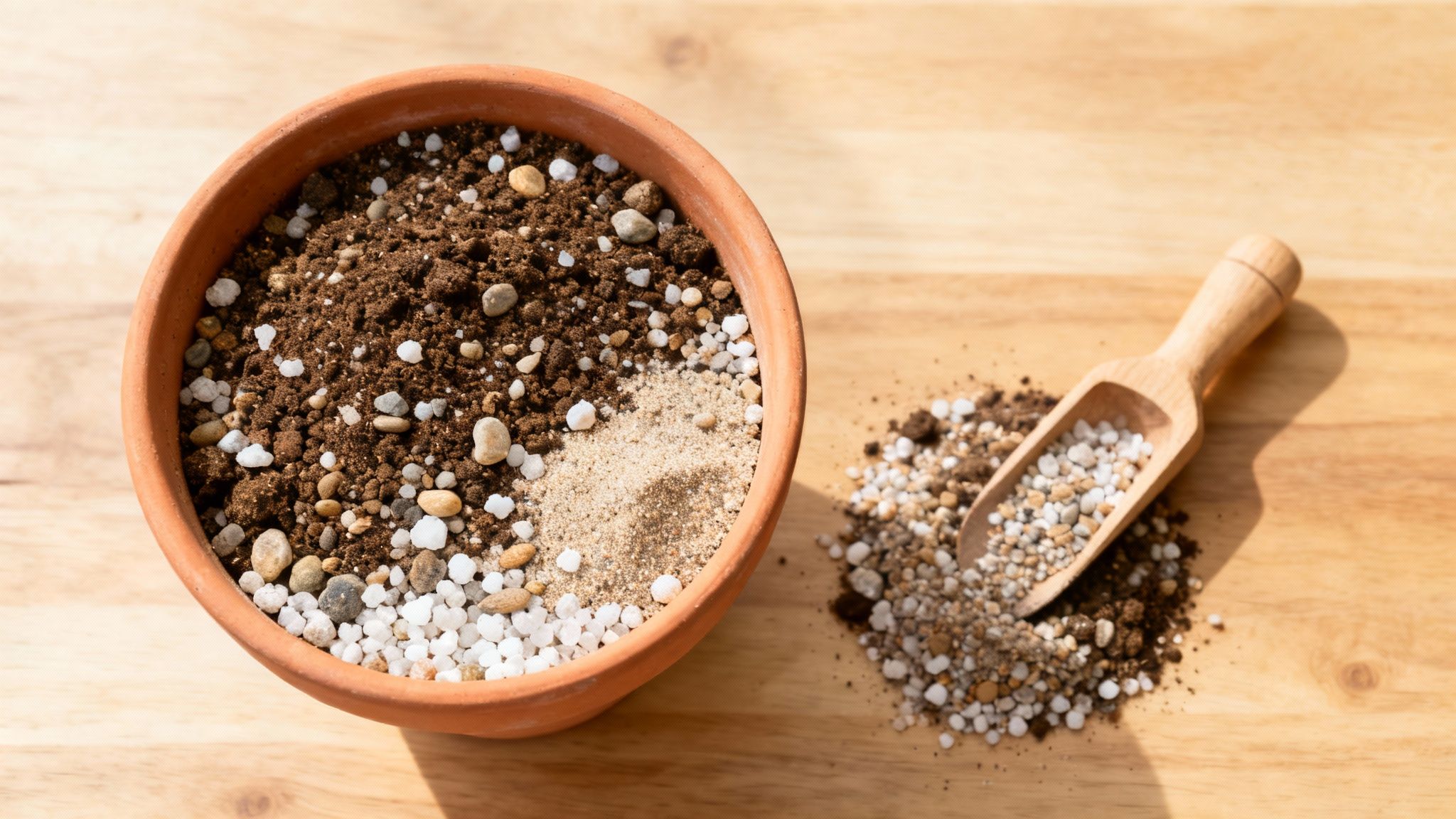
You can follow every watering rule in the book, but if your cactus is sitting in the wrong home, it’s all for nothing. The secret to preventing the dreaded root rot isn’t just about how you water—it starts long before you even pick up the watering can. It all comes down to the pot and the soil.
Nailing these two basics makes the whole watering a cactus plant process much more forgiving. Think of it as a safety net. The right setup wicks away excess moisture and lets the roots breathe, which is exactly what these desert natives need to feel at home.
Choosing the Perfect Pot
When it comes to pots, one material is the undisputed champion for cacti: unglazed terracotta or clay. These pots are porous, meaning they literally breathe. This helps moisture evaporate right through the sides of the pot, letting the soil dry out faster and more evenly.
But here’s the real deal-breaker: whatever pot you choose must have a drainage hole. This is non-negotiable. Without a clear exit path for excess water, your cactus’s roots will be stuck in a swamp, and root rot is pretty much guaranteed.
Your pot is more than a container; it's a crucial part of your plant's respiratory system. A breathable pot with good drainage is the first and most important line of defense against overwatering.
Crafting the Ideal Soil Mix
Standard, all-purpose potting soil is a cactus’s worst enemy. It’s designed to hold onto moisture, which is the exact opposite of what you want. Cacti crave a gritty, airy soil that water can rush right through. You’ve got two solid options here: buy a pre-made blend or mix your own.
Commercial Cactus/Succulent Soil: Grab a bag specifically made for cacti and succulents. Check the ingredients for things like pumice, perlite, or coarse sand. These gritty materials create air pockets and stop the soil from turning into a dense brick.
DIY Cactus Mix: Mixing your own is super easy and gives you total control. A foolproof recipe to start with is one part standard potting soil, one part coarse sand, and one part perlite or pumice.
The whole point is to create a substrate that drains almost instantly. This structure, combined with a terracotta pot, sets the stage for happy, healthy roots. If you want to nerd out on the science, our guide on mastering soil pH takes a much deeper dive into how soil composition really impacts your plants.
Your Top Cactus Watering Questions Answered
Even with the best intentions, cactus care can throw you a curveball now and then. Let's tackle some of the most common questions from fellow growers. Getting these right will make all the difference.
Can I Use Ice Cubes to Water My Cactus?
That's a hard no. This is one of those internet "hacks" that sounds clever but can do real damage. Cacti come from warm, dry climates, and their roots are simply not built to handle an ice-cold shock. The freezing temperature can stress or even kill the delicate root system, opening the door for rot. Always stick to room-temperature water.
Should I Mist My Cactus?
For the classic desert cacti most of us grow, misting is a bad idea. It doesn't get water down to the roots where it's needed, and worse, it can cause problems. Water droplets sitting on the cactus skin, especially in a stuffy room, can invite fungal diseases and rot. The only real exception here is for epiphytic or jungle cacti like the Christmas Cactus (Schlumbergera buckleyi), which come from more humid environments and actually appreciate the occasional mist.
What If My Pot Has No Drainage Hole?
Ah, the beautiful but dangerous decorative pot. While they look great, a pot without a drainage hole is a death trap for a cactus. Water will inevitably pool at the bottom, creating a swampy mess that suffocates the roots and leads to certain rot. If you've fallen in love with a pot that has no hole, don't despair! Use it as a "cachepot"—a pretty outer container. Keep your cactus in its simple plastic nursery pot (with drainage!) and just pop that inside the decorative one. You get the look you want without sacrificing your plant's health.
Mastering the art of watering a cactus plant is about observation and understanding, not just a schedule. By learning the soak-and-dry method, paying attention to seasonal changes, and providing the right pot and soil, you can grow healthy, thriving cacti for years to come. Remember to check your soil, watch for signs of stress, and connect with other growers when you need advice.
Turn your phone into a plant expert. Discover smart care reminders with Tendra - where local gardeners connect and thrive.
